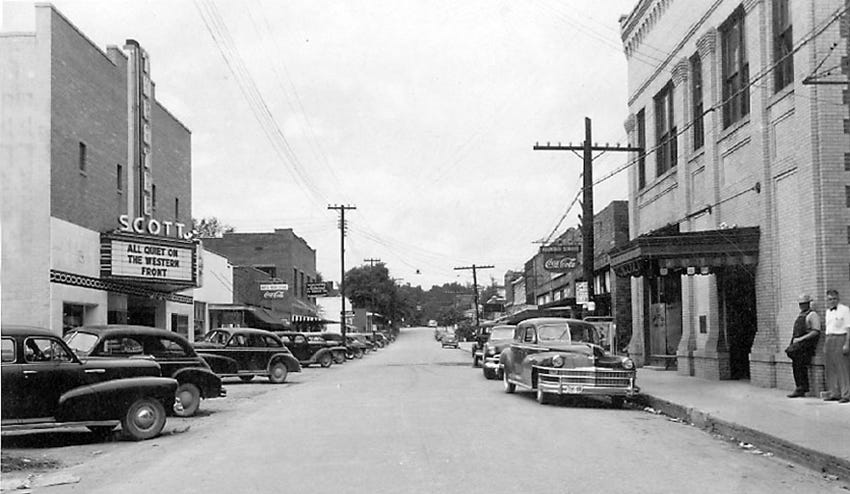You’re reading “Echoes in Time,” a weekly newsletter by the Independent Herald that focuses on stories of years gone by in order to paint a portrait of Scott County and its people. “Echoes in Time” is one of six weekly newsletters published by the IH. You can adjust your subscription settings to include as many or as few of these newsletters as you want. If you aren’t a subscriber, please consider doing so. It’s free!
Today’s newsletter is sponsored by the Scott County Chamber of Commerce. Since 1954, the Scott County Chamber of Commerce has advocated for a strong community by supporting stronger infrastructure and leadership.
How Oneida got its name
Prior to the building of the Cincinnati-Southern Railroad in the late 1870s, Oneida was little more than forests and a few farms. There was an open meadow in the area of south Main Street, and a dense virgin forest near the Four Lane that lended its name to the Oak Grove district. A few families had settled, first the Terry family who built near where Hardee’s is now located and then the Methodist circuit rider Isaac Smith, who liked the area so much that he settled at Ponderosa, and others. But Oneida, as we know it today, didn’t exist. The area was called Pine Creek.
That all changed after construction of the railroad was completed in 1880. That open meadow where the tracks made a gentle, sweeping turn along the banks of Pine Creek was the location of a railroad siding that allowed trains to pass, and then became a bustling depot. Businesses sprang up around the depot, and the region was opened to exploration for coal and timber — which led to the establishment of even more railroads. Of 14 independent branch lines along the Cincinnati-Southern route between Cincinnati and Chattanooga, half of them were located in or traveled into Scott County, and all of those were related to the mining and logging industries. Along the way, towns sprang up that were much larger than the growing town at the depot on Pine Creek — including Norcross (Norma) on the Tennessee Railroad; Glenmary, which was the site of an unnamed branch line to mining operations at Coal Hill; Helenwood, which was the site of an unnamed branch line to mining operations at Sulpher Creek; and Robbins, which was the site of the Knoxville & New River Railroad across Ridge Road to Brimstone Creek.
In time, though, those towns faded. That town along the siding in the meadow near Pine Creek, which had been named Oneida, grew to become the largest hub of commerce in Scott County, and has remained so ever since.
Through the years, it has often been written that Oneida got its name from railroad officials who were reminded of their home in Oneida County, N.Y., without any indication of who those railroad officials were or why they were reminded of their New York home. That old legend is rooted in truth, but in a round-about way. Oneida, Tenn. was actually named for a small village of the same name in Ohio — which was itself named for Oneida County, N.Y. Here’s how it happened.
The need for a name
When the Cincinnati-Southern was designed, it was designed with a time-table system in mind that would allow multiple trains to travel the rails at the same time without colliding. As it was originally built, the railroad consisted of a single set of tracks. But there were side tracks built all along the route to allow trains to pass. The time-table was meticulously planned so that trains would arrive at the sidings at precise times. Otherwise, deadly collisions would occur between northbound and southbound trains. As was common practice in those days, when place names were few and far between in rural areas, each siding and each depot was given a name. In Scott County, the only official “places” that the railroad ran through when it was built in 1879 and 1880 was Isham at the Tennessee-Kentucky line, and Rugby Road. The new sidings were given names that included Oneida, High Point, Helenwood, Robbins, and Elgin. We don’t know how Helenwood received its name, but High Point was named because it was the highest point of elevation along the railroad between Cincinnati and Chattanooga. It would have typically been named Summit, but railroad officials wanted to avoid confusion with Somerset further north. Robbins was named for the man who oversaw construction of Tunnel #15 just north of there. Elgin was renamed from Rugby Road to avoid confusion with Rockwood further south.
And, thanks to historian G. Allen Storey, who wrote extensively about the railroad for the FNB Chronicle, we know that Oneida took its name from Oneida, Oh. Storey was the son of Glenn Storey, a long-time employee of Norfolk-Southern Railroad.
Storey wrote: “The railroad entered the county in 1879, passing through Isham and then along its course to the small trestle at Bear Creek. It would then take a gentle westerly curve in an open plain and then turn south again a mile later. A siding and a branch line switch in this meadow would give cause for one of the Cincinnati Southern’s Chattanooga lawyers, Charles D. McGuffy, to name the place ‘Oneida,’ after his hometown of Oneida, Ohio.”
From Ohio to Tennessee
Charles D. McGuffey wasn’t actually from Oneida, Oh., but his wife was.
Born Charles Drake McGuffey on June 12, 1842, he was an attorney for the town of Cincinnati and was involved with the building of the Cincinnati-Southern Railroad through Scott County. His father, interestingly enough, was Alexander Hamilton McGuffey — who co-wrote the McGuffey Readers with his brother, Charles’ uncle, William Holmes McGuffey. The McGuffey Readers were popular reading textbooks in American public schools in the 19th century, and are believed to have helped teach millions of children across the U.S. to read.
McGuffey married Mary E. Hull in 1876, just before construction of the railroad began. She was the daughter of Patrick Clark Hull and Harriet A. Beess. They had one son, Charles Hull McGuffey, who died in 1881 at the age of three.
McGuffey’s hometown was Cincinnati. It was where he was born and raised and spent most of his life. But his wife, Mary, was from an unincorporated village further north — a tiny place southeast of Canton, Oh. that was named Oneida Mills.
Oneida Mills — known simply as Oneida, Oh. — was named by George Hull, Mary’s uncle, who built a grist mill there in 1840. The mill was later operated by Mary’s father, Patrick Clark Hull. George and Patrick were from Oneida County, N.Y. And they named the site of their new mill after their old hometown. The home Patrick owned — where Mary grew up — still stands and is listed on the National Register of Historic Places in Oneida, Oh.
Despite them both being from Ohio, Charles McGuffey and Mary Hull didn’t meet in Ohio. Rather, they met in Knoxville. Charles was in Tennessee on business associated with planning for the new railroad. Mary, a schoolteacher, suffered from poor health her entire adult life and traveled south during the winter months in an effort to improve her condition. She was visiting Knoxville when she met Charles, and they were married in 1876.
While her husband worked on the railroad, Mary continued to live with her father in Oneida, Oh. when she was back north during the summer months. And, down south, when the railroad construction gang reached the meadow at the place where the railroad made a gentle, sweeping turn by Pine Creek, McGuffey chose to name the siding Oneida — after his wife’s home in Oneida, Oh., which her father had named after his home in Oneida County, N.Y.
The conclusion of the story
By the turn of the century, that little railroad siding in the meadow was a happening place. The Paint Rock Coal & Coke Co. began a railroad (later to become the Tennessee Railroad) in the 1890s. Businessmen who owned mills at Glenmary and Verdun began building the Oneida & Western Railroad to Jamestown shortly after that. Both railroads were headquartered in Oneida. In 1904, businessman Claiborn Cross — whose father, Larkin Cross, had been murdered by Confederate soldiers on Buffalo Creek during the Civil War — started First National Bank, and Oneida was officially becoming a town. The town incorporated in 1917.
It was just before the town’s incorporation in 1915 that the Oneida Independent School District — a forerunner to the Oneida Special School District — was formed by the Tennessee General Assembly. Oneida High School chose the “Indians” as its mascot, a tip of the hat to the fact that Oneida, Tenn. had been named after Oneida County, N.Y. You see, Oneida County — which was the namesake for Oneida, Oh., which was in turn the namesake for Oneida, Tenn. — was named for the Oneida Indian Nation, one of the original tribes of the Iroquois Confederacy. Their name — “Onyota’a:ka” in their own language — translates to “People of the Standing Stone.” The name was born of a legend that these native people had the ability to shapeshift into stones.
So, in a nutshell: the Native Americans in upstate New York were known as the Oneida tribe — translated from the native word “Onyota’a:ka,” which means “People of the Standing Stone” and chosen because of an old legend that members of the tribe could shapeshift into stones — and that name was given to Oneida County, N.Y. A resident of the county moved to Ohio and assigned the name to the area where he built a grist mill, and the man who married his daughter then carried the name to Scott County, Tennessee with the building of the railroad that would breathe life into what would become the northern Cumberland Plateau’s largest town.
Charles McGuffey died in Chattanooga on Sept. 28, 1916 and is buried at Old Gray Cemetery in Knoxville. Mary died in DeLand, Fla. on Dec. 30, 1885. She and their son are buried at Massillon City Cemetery in Ohio. Patrick Clark Hull died Dec. 7, 1887 when a carriage he was riding in collided with a train in Oneida, Oh. He was also buried at Massillon City Cemetery. His brother, George, was so shocked by the news of Patrick’s death that he died the following day.
Thank you for reading. Our next newsletters will be Threads of Life on Wednesday and The WeekenderThursday evening. Want to update your subscription to add or subtract these newsletters? Do so here. Need to subscribe? Enter your email address below!
◼️ Monday morning: The Daybreaker (news & the week ahead)
◼️ Tuesday: Echoes in Time (stories of our history)
◼️ Wednesday: Threads of Life (obituaries)
◼️ Thursday evening: The Weekender (news & the weekend)
◼️ Friday: Friday Features (beyond the news)
◼️ Sunday: Varsity (a weekly sports recap)




